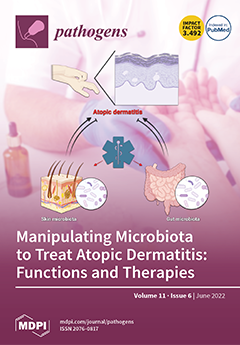Salmonella is one of the most common bacteria causing food poisoning worldwide. We evaluated the prevalence, the serotypes, and the antimicrobial resistance (AMR) of
Salmonella isolates from many kinds of food, particularly pork and chicken in retail, in Taiwan between January 2017 and
[...] Read more.
Salmonella is one of the most common bacteria causing food poisoning worldwide. We evaluated the prevalence, the serotypes, and the antimicrobial resistance (AMR) of
Salmonella isolates from many kinds of food, particularly pork and chicken in retail, in Taiwan between January 2017 and December 2019. The E-test was used to assess antimicrobial susceptibility and a polymerase chain reaction was performed for serotyping. A total of 459 different foods were investigated, and 117
Salmonella strains were isolated. Retail pork and chicken were the most common
Salmonella-contaminated foods (64.1% and 29.1%, respectively). Of the 117 isolates, 23 serotypes were identified. The serotypes Derby (16.2%), Anatum (13.7%), and Agona (8.5%) were the most prevalent. The resistance rates to ciprofloxacin, ceftriaxone, and carbapenem were 41.9%, 11.1%, and 1.7%, respectively. The Derby and Anatum serotypes were prevalent in chicken and pork; the Anatum serotype had significantly higher ciprofloxacin and ceftriaxone resistance rates and was highly prevalent in 2017 and 2018. Multi-locus sequence typing analysis revealed that the 58 randomly chosen
Salmonella isolates belonged to 18 sequence types (STs). ST64 (Anatum, 16 out of 58, 27.6%) was the most common, followed by ST321 (Muenster, 6/58, 10.3%), ST831 (Give, 5/58, 8.6%), ST155 (London, 4/58, 6.9%) and ST314 (Kentucky, 4/58, 6.9%). Multidrug-resistant
Salmonella strains were remarkably observed in the serotypes Anatum (ST64) and Goldcoast (ST358). This study revealed that retail pork was commonly contaminated with antimicrobial-resistant
Salmonella. Thus, periodic investigations of
Salmonella serotypes and AMR are needed.
Full article






